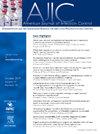利用机器学习将电子手部卫生审核系统与电子健康记录整合,预测医疗机构中的医院感染。
IF 3.8
3区 医学
Q2 INFECTIOUS DISEASES
引用次数: 0
摘要
背景:医院获得性感染(HAIs)会增加发病率、死亡率和医疗成本。有效的手部卫生(HH)是预防感染的关键,但实现高依从性仍是一项挑战。本研究探讨了如何利用机器学习将手部卫生电子审核系统与电子健康记录整合,以预测 HAIs:方法:2017-2020年间,巴西一家医院开展了一项回顾性队列研究。HH 合规性以电子方式记录,患者数据则从电子健康记录中收集。主要结果是根据 CDC/NHSN 监测定义得出的 HAIs。预测建模采用了机器学习算法,与随机过度采样实例(ROSE)相平衡,包括广义线性模型(GLM);位置、规模和形状的广义加性模型(GAMLSS);随机森林;支持向量机和极端梯度提升(XGboost):对 6,253 名患者中的 125 人(2%)发生 HAIs,以及 920,489 次 HH 机会(49.3% 合规)进行了分析。观察到 HH 合规性与 HAI 之间存在直接关联。采用 ROSE 的 GLM 算法表现优异,灵敏度为 84.2%,特异度为 82.9%,AUC 为 93%:结论:将电子卫生保健审计系统与电子健康记录整合并使用机器学习模型可以加强感染控制监测并预测患者的预后。要验证这些发现并将其融入临床实践,还需要进一步的研究。本文章由计算机程序翻译,如有差异,请以英文原文为准。

Integration of an electronic hand hygiene auditing system with electronic health records using machine learning to predict hospital-acquired infection in a health care setting
Background
Hospital-acquired infections (HAIs) increase morbidity, mortality, and health care costs. Effective hand hygiene (HH) is crucial for prevention, but achieving high compliance remains challenge. This study explores using machine learning to integrate an electronic HH auditing system with electronic health records to predict HAIs.
Methods
A retrospective cohort study was conducted at a Brazilian hospital during 2017-2020. HH compliance was recorded electronically, and patient data were collected from electronic health records. The primary outcomes were HAIs per CDC/National Healthcare Safety Network surveillance definitions. Machine learning algorithms, balanced with Random Over Sampling Examples (ROSE), were utilized for predictive modeling, including generalized linear models (GLM); generalized additive models for location, scale, and shape (GAMLSS); random forest; support vector machine; and extreme gradient boosting (XGboost).
Results
125 of 6,253 patients (2%) developed HAIs and 920,489 HH opportunities (49.3% compliance) were analyzed. A direct correlation between HH compliance and HAIs was observed. The GLM algorithm with ROSE demonstrated superior performance, with 84.2% sensitivity, 82.9% specificity, and a 93% AUC.
Conclusions
Integrating electronic HH auditing systems with electronic health records and using machine learning models can enhance infection control surveillance and predict patient outcomes. Further research is needed to validate these findings and integrate them into clinical practice.
求助全文
通过发布文献求助,成功后即可免费获取论文全文。
去求助
来源期刊
CiteScore
7.40
自引率
4.10%
发文量
479
审稿时长
24 days
期刊介绍:
AJIC covers key topics and issues in infection control and epidemiology. Infection control professionals, including physicians, nurses, and epidemiologists, rely on AJIC for peer-reviewed articles covering clinical topics as well as original research. As the official publication of the Association for Professionals in Infection Control and Epidemiology (APIC)

 求助内容:
求助内容: 应助结果提醒方式:
应助结果提醒方式:


